Environmental Strategies: Tourism Planning & Great Barrier Reef
VerifiedAdded on 2023/06/06
|26
|6165
|413
Report
AI Summary
This report provides an overview of tourism planning strategies aimed at protecting the Great Barrier Reef. It discusses the roles and responsibilities of an Australian organization focused on the reef's long-term sustainability, addressing issues such as coral bleaching, water quality, climate change, and overfishing. The report highlights the economic and environmental importance of the reef, detailing the need for new policies and the involvement of various stakeholders. It examines existing government plans and legislations, explores potential policy approaches and instruments, and outlines a proposed planning process for implementing and reviewing conservation efforts. The report emphasizes the importance of sustainable development and eco-tourism in preserving the Great Barrier Reef for future generations, while acknowledging the challenges and opportunities in this sector.
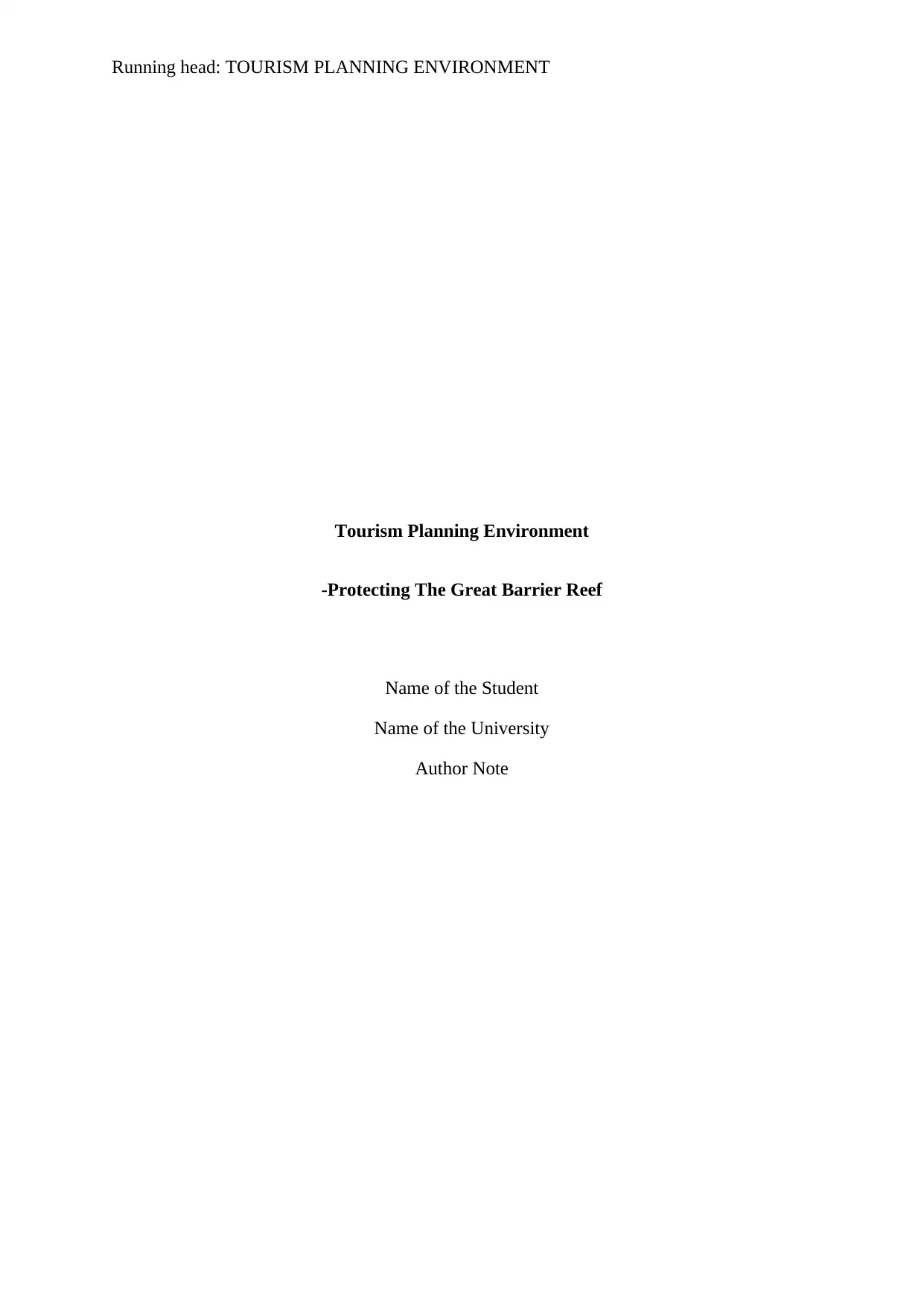
Running head: TOURISM PLANNING ENVIRONMENT
Tourism Planning Environment
-Protecting The Great Barrier Reef
Name of the Student
Name of the University
Author Note
Tourism Planning Environment
-Protecting The Great Barrier Reef
Name of the Student
Name of the University
Author Note
Paraphrase This Document
Need a fresh take? Get an instant paraphrase of this document with our AI Paraphraser
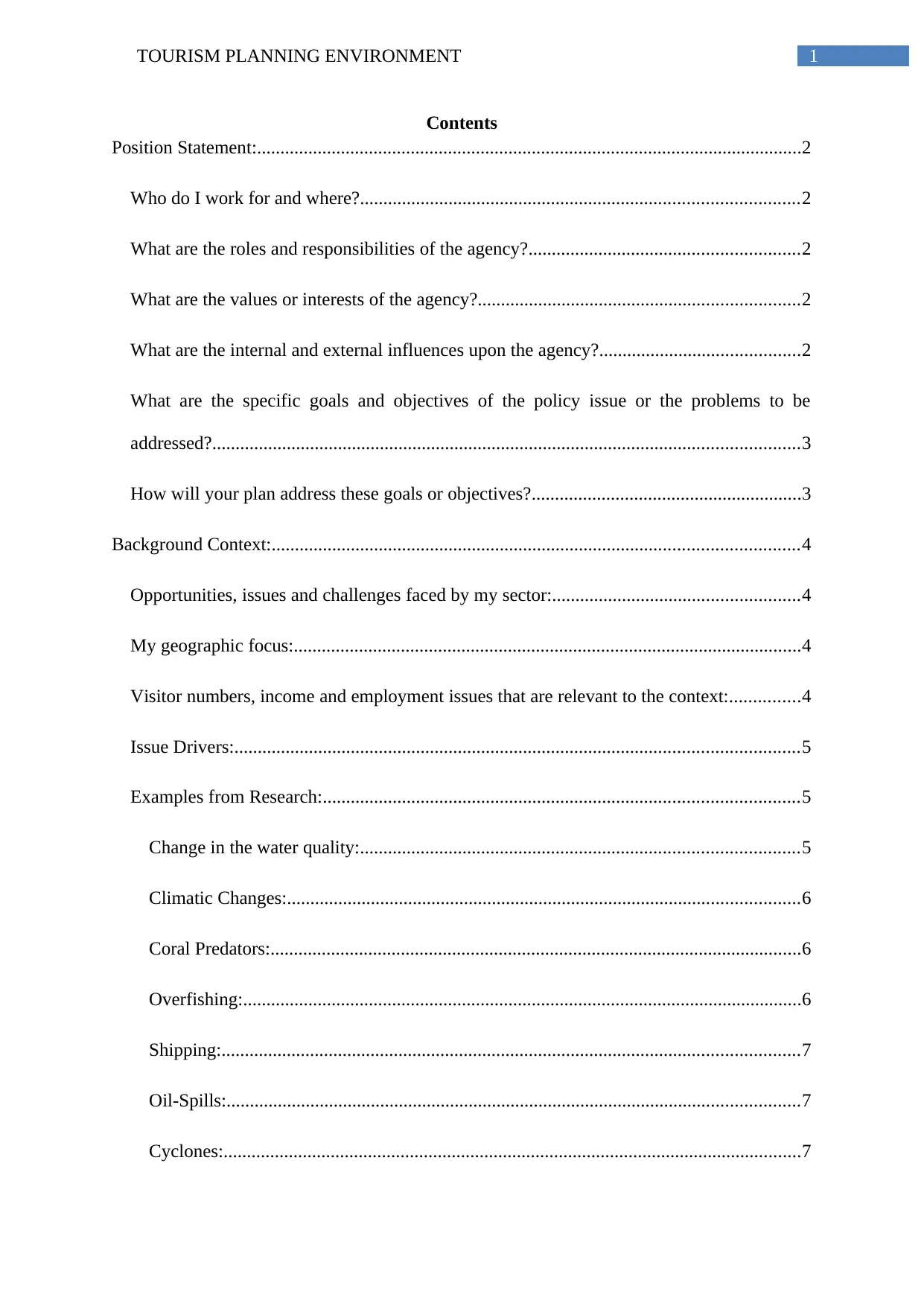
1TOURISM PLANNING ENVIRONMENT
Contents
Position Statement:.....................................................................................................................2
Who do I work for and where?..............................................................................................2
What are the roles and responsibilities of the agency?..........................................................2
What are the values or interests of the agency?.....................................................................2
What are the internal and external influences upon the agency?...........................................2
What are the specific goals and objectives of the policy issue or the problems to be
addressed?..............................................................................................................................3
How will your plan address these goals or objectives?..........................................................3
Background Context:.................................................................................................................4
Opportunities, issues and challenges faced by my sector:.....................................................4
My geographic focus:.............................................................................................................4
Visitor numbers, income and employment issues that are relevant to the context:...............4
Issue Drivers:.........................................................................................................................5
Examples from Research:......................................................................................................5
Change in the water quality:..............................................................................................5
Climatic Changes:..............................................................................................................6
Coral Predators:..................................................................................................................6
Overfishing:........................................................................................................................6
Shipping:............................................................................................................................7
Oil-Spills:...........................................................................................................................7
Cyclones:............................................................................................................................7
Contents
Position Statement:.....................................................................................................................2
Who do I work for and where?..............................................................................................2
What are the roles and responsibilities of the agency?..........................................................2
What are the values or interests of the agency?.....................................................................2
What are the internal and external influences upon the agency?...........................................2
What are the specific goals and objectives of the policy issue or the problems to be
addressed?..............................................................................................................................3
How will your plan address these goals or objectives?..........................................................3
Background Context:.................................................................................................................4
Opportunities, issues and challenges faced by my sector:.....................................................4
My geographic focus:.............................................................................................................4
Visitor numbers, income and employment issues that are relevant to the context:...............4
Issue Drivers:.........................................................................................................................5
Examples from Research:......................................................................................................5
Change in the water quality:..............................................................................................5
Climatic Changes:..............................................................................................................6
Coral Predators:..................................................................................................................6
Overfishing:........................................................................................................................6
Shipping:............................................................................................................................7
Oil-Spills:...........................................................................................................................7
Cyclones:............................................................................................................................7
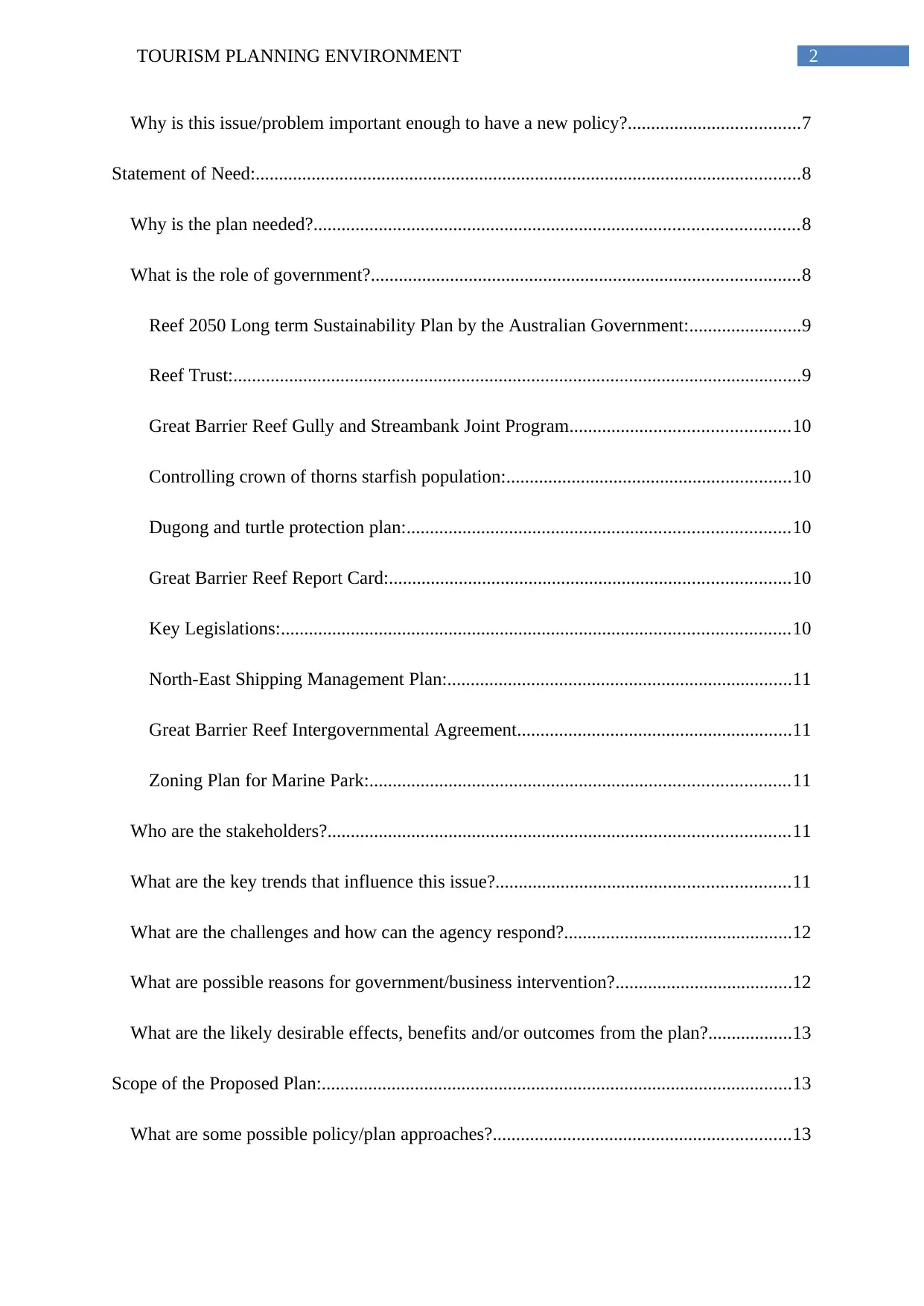
2TOURISM PLANNING ENVIRONMENT
Why is this issue/problem important enough to have a new policy?.....................................7
Statement of Need:.....................................................................................................................8
Why is the plan needed?........................................................................................................8
What is the role of government?............................................................................................8
Reef 2050 Long term Sustainability Plan by the Australian Government:........................9
Reef Trust:..........................................................................................................................9
Great Barrier Reef Gully and Streambank Joint Program...............................................10
Controlling crown of thorns starfish population:.............................................................10
Dugong and turtle protection plan:..................................................................................10
Great Barrier Reef Report Card:......................................................................................10
Key Legislations:.............................................................................................................10
North-East Shipping Management Plan:..........................................................................11
Great Barrier Reef Intergovernmental Agreement...........................................................11
Zoning Plan for Marine Park:..........................................................................................11
Who are the stakeholders?...................................................................................................11
What are the key trends that influence this issue?...............................................................11
What are the challenges and how can the agency respond?.................................................12
What are possible reasons for government/business intervention?......................................12
What are the likely desirable effects, benefits and/or outcomes from the plan?..................13
Scope of the Proposed Plan:.....................................................................................................13
What are some possible policy/plan approaches?................................................................13
Why is this issue/problem important enough to have a new policy?.....................................7
Statement of Need:.....................................................................................................................8
Why is the plan needed?........................................................................................................8
What is the role of government?............................................................................................8
Reef 2050 Long term Sustainability Plan by the Australian Government:........................9
Reef Trust:..........................................................................................................................9
Great Barrier Reef Gully and Streambank Joint Program...............................................10
Controlling crown of thorns starfish population:.............................................................10
Dugong and turtle protection plan:..................................................................................10
Great Barrier Reef Report Card:......................................................................................10
Key Legislations:.............................................................................................................10
North-East Shipping Management Plan:..........................................................................11
Great Barrier Reef Intergovernmental Agreement...........................................................11
Zoning Plan for Marine Park:..........................................................................................11
Who are the stakeholders?...................................................................................................11
What are the key trends that influence this issue?...............................................................11
What are the challenges and how can the agency respond?.................................................12
What are possible reasons for government/business intervention?......................................12
What are the likely desirable effects, benefits and/or outcomes from the plan?..................13
Scope of the Proposed Plan:.....................................................................................................13
What are some possible policy/plan approaches?................................................................13
⊘ This is a preview!⊘
Do you want full access?
Subscribe today to unlock all pages.

Trusted by 1+ million students worldwide
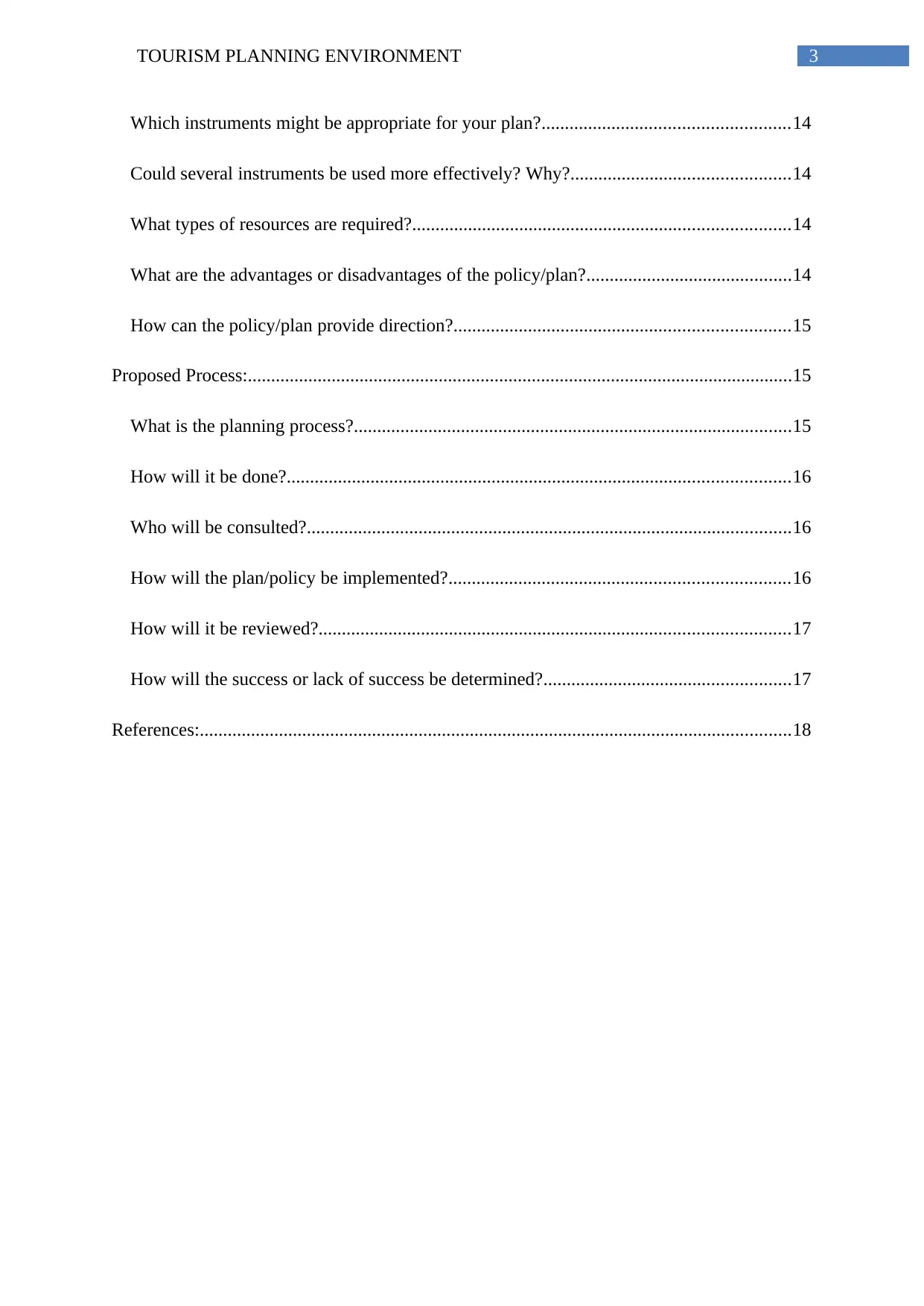
3TOURISM PLANNING ENVIRONMENT
Which instruments might be appropriate for your plan?.....................................................14
Could several instruments be used more effectively? Why?...............................................14
What types of resources are required?.................................................................................14
What are the advantages or disadvantages of the policy/plan?............................................14
How can the policy/plan provide direction?........................................................................15
Proposed Process:.....................................................................................................................15
What is the planning process?..............................................................................................15
How will it be done?............................................................................................................16
Who will be consulted?........................................................................................................16
How will the plan/policy be implemented?.........................................................................16
How will it be reviewed?.....................................................................................................17
How will the success or lack of success be determined?.....................................................17
References:...............................................................................................................................18
Which instruments might be appropriate for your plan?.....................................................14
Could several instruments be used more effectively? Why?...............................................14
What types of resources are required?.................................................................................14
What are the advantages or disadvantages of the policy/plan?............................................14
How can the policy/plan provide direction?........................................................................15
Proposed Process:.....................................................................................................................15
What is the planning process?..............................................................................................15
How will it be done?............................................................................................................16
Who will be consulted?........................................................................................................16
How will the plan/policy be implemented?.........................................................................16
How will it be reviewed?.....................................................................................................17
How will the success or lack of success be determined?.....................................................17
References:...............................................................................................................................18
Paraphrase This Document
Need a fresh take? Get an instant paraphrase of this document with our AI Paraphraser
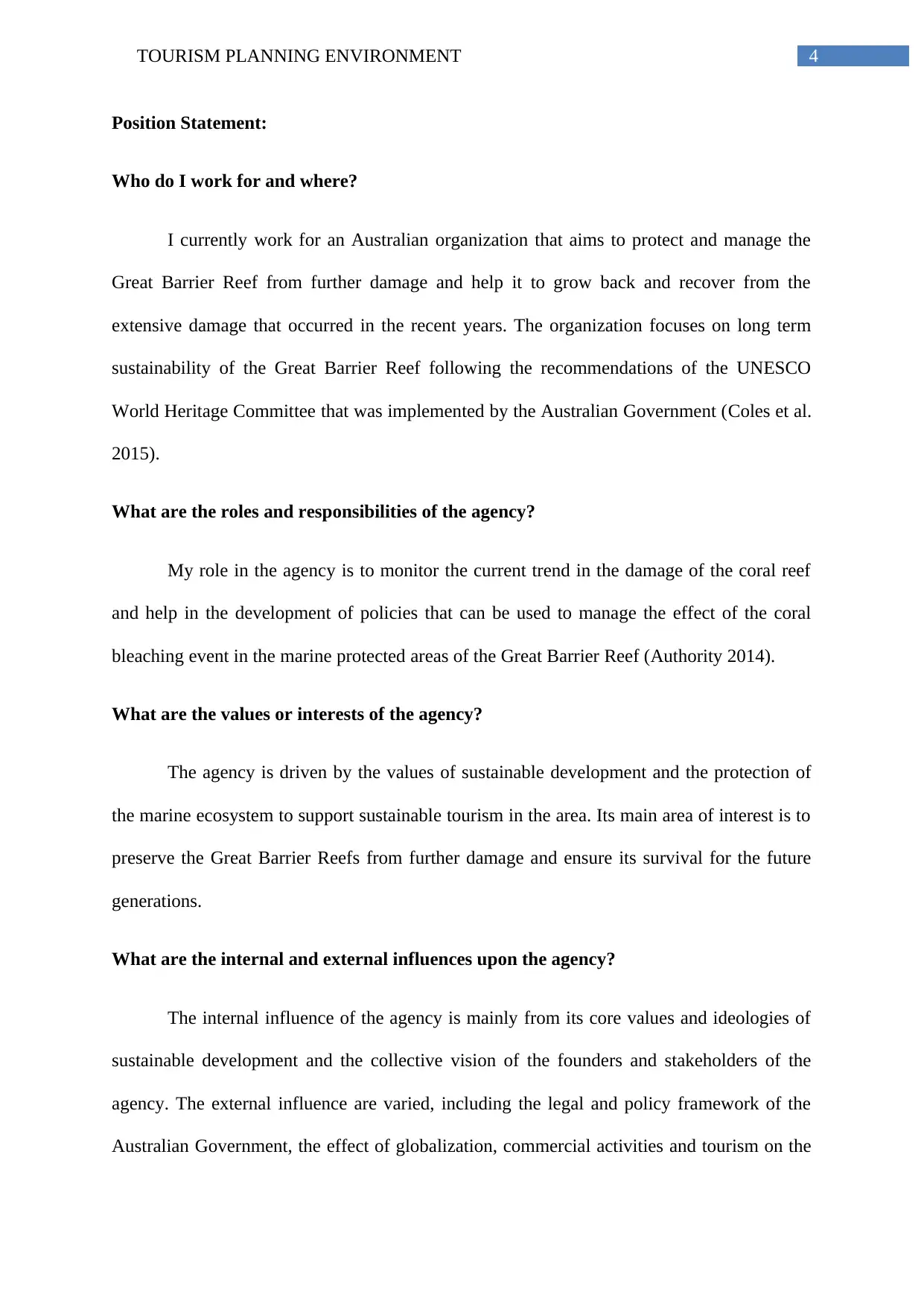
4TOURISM PLANNING ENVIRONMENT
Position Statement:
Who do I work for and where?
I currently work for an Australian organization that aims to protect and manage the
Great Barrier Reef from further damage and help it to grow back and recover from the
extensive damage that occurred in the recent years. The organization focuses on long term
sustainability of the Great Barrier Reef following the recommendations of the UNESCO
World Heritage Committee that was implemented by the Australian Government (Coles et al.
2015).
What are the roles and responsibilities of the agency?
My role in the agency is to monitor the current trend in the damage of the coral reef
and help in the development of policies that can be used to manage the effect of the coral
bleaching event in the marine protected areas of the Great Barrier Reef (Authority 2014).
What are the values or interests of the agency?
The agency is driven by the values of sustainable development and the protection of
the marine ecosystem to support sustainable tourism in the area. Its main area of interest is to
preserve the Great Barrier Reefs from further damage and ensure its survival for the future
generations.
What are the internal and external influences upon the agency?
The internal influence of the agency is mainly from its core values and ideologies of
sustainable development and the collective vision of the founders and stakeholders of the
agency. The external influence are varied, including the legal and policy framework of the
Australian Government, the effect of globalization, commercial activities and tourism on the
Position Statement:
Who do I work for and where?
I currently work for an Australian organization that aims to protect and manage the
Great Barrier Reef from further damage and help it to grow back and recover from the
extensive damage that occurred in the recent years. The organization focuses on long term
sustainability of the Great Barrier Reef following the recommendations of the UNESCO
World Heritage Committee that was implemented by the Australian Government (Coles et al.
2015).
What are the roles and responsibilities of the agency?
My role in the agency is to monitor the current trend in the damage of the coral reef
and help in the development of policies that can be used to manage the effect of the coral
bleaching event in the marine protected areas of the Great Barrier Reef (Authority 2014).
What are the values or interests of the agency?
The agency is driven by the values of sustainable development and the protection of
the marine ecosystem to support sustainable tourism in the area. Its main area of interest is to
preserve the Great Barrier Reefs from further damage and ensure its survival for the future
generations.
What are the internal and external influences upon the agency?
The internal influence of the agency is mainly from its core values and ideologies of
sustainable development and the collective vision of the founders and stakeholders of the
agency. The external influence are varied, including the legal and policy framework of the
Australian Government, the effect of globalization, commercial activities and tourism on the
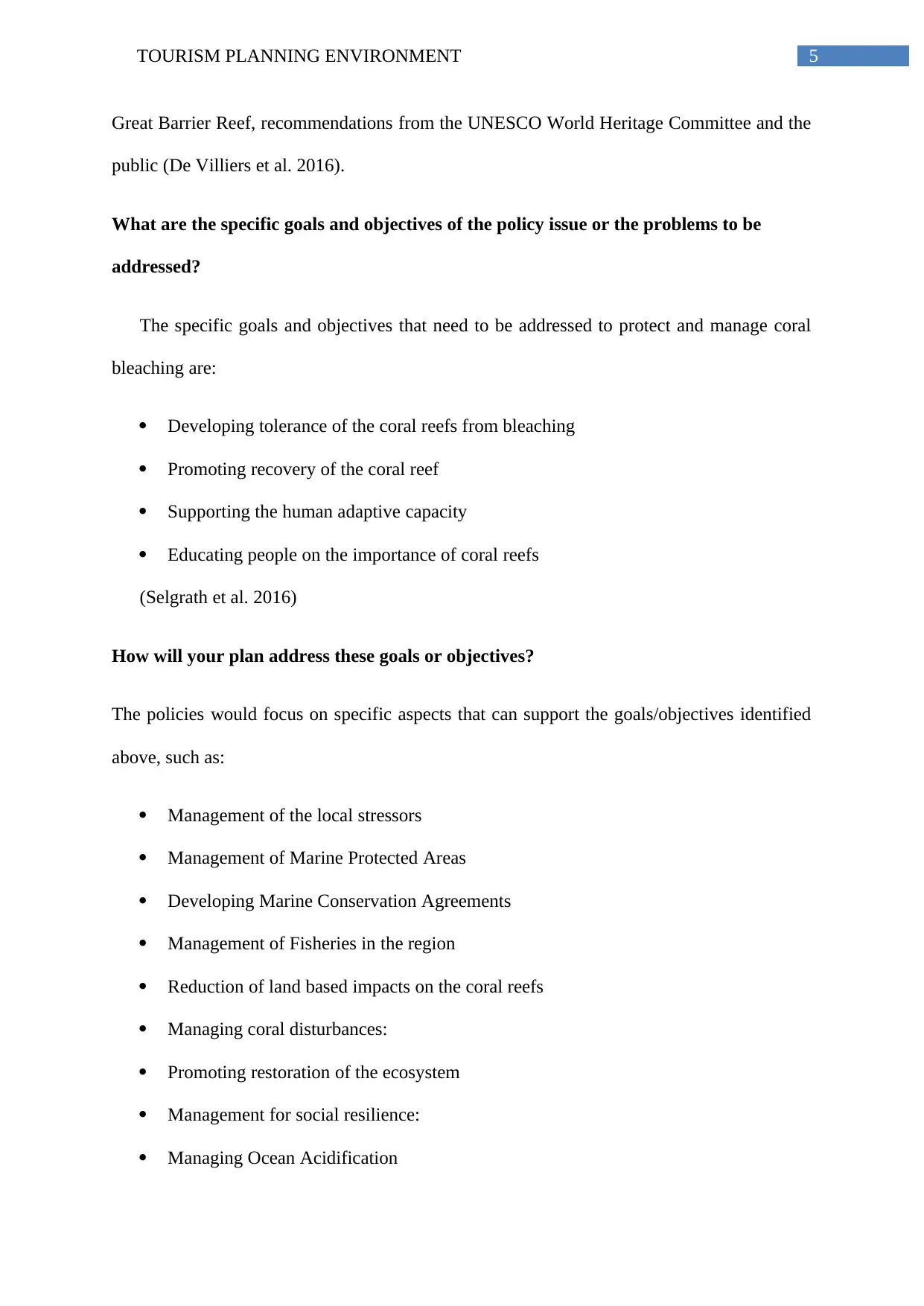
5TOURISM PLANNING ENVIRONMENT
Great Barrier Reef, recommendations from the UNESCO World Heritage Committee and the
public (De Villiers et al. 2016).
What are the specific goals and objectives of the policy issue or the problems to be
addressed?
The specific goals and objectives that need to be addressed to protect and manage coral
bleaching are:
Developing tolerance of the coral reefs from bleaching
Promoting recovery of the coral reef
Supporting the human adaptive capacity
Educating people on the importance of coral reefs
(Selgrath et al. 2016)
How will your plan address these goals or objectives?
The policies would focus on specific aspects that can support the goals/objectives identified
above, such as:
Management of the local stressors
Management of Marine Protected Areas
Developing Marine Conservation Agreements
Management of Fisheries in the region
Reduction of land based impacts on the coral reefs
Managing coral disturbances:
Promoting restoration of the ecosystem
Management for social resilience:
Managing Ocean Acidification
Great Barrier Reef, recommendations from the UNESCO World Heritage Committee and the
public (De Villiers et al. 2016).
What are the specific goals and objectives of the policy issue or the problems to be
addressed?
The specific goals and objectives that need to be addressed to protect and manage coral
bleaching are:
Developing tolerance of the coral reefs from bleaching
Promoting recovery of the coral reef
Supporting the human adaptive capacity
Educating people on the importance of coral reefs
(Selgrath et al. 2016)
How will your plan address these goals or objectives?
The policies would focus on specific aspects that can support the goals/objectives identified
above, such as:
Management of the local stressors
Management of Marine Protected Areas
Developing Marine Conservation Agreements
Management of Fisheries in the region
Reduction of land based impacts on the coral reefs
Managing coral disturbances:
Promoting restoration of the ecosystem
Management for social resilience:
Managing Ocean Acidification
⊘ This is a preview!⊘
Do you want full access?
Subscribe today to unlock all pages.

Trusted by 1+ million students worldwide
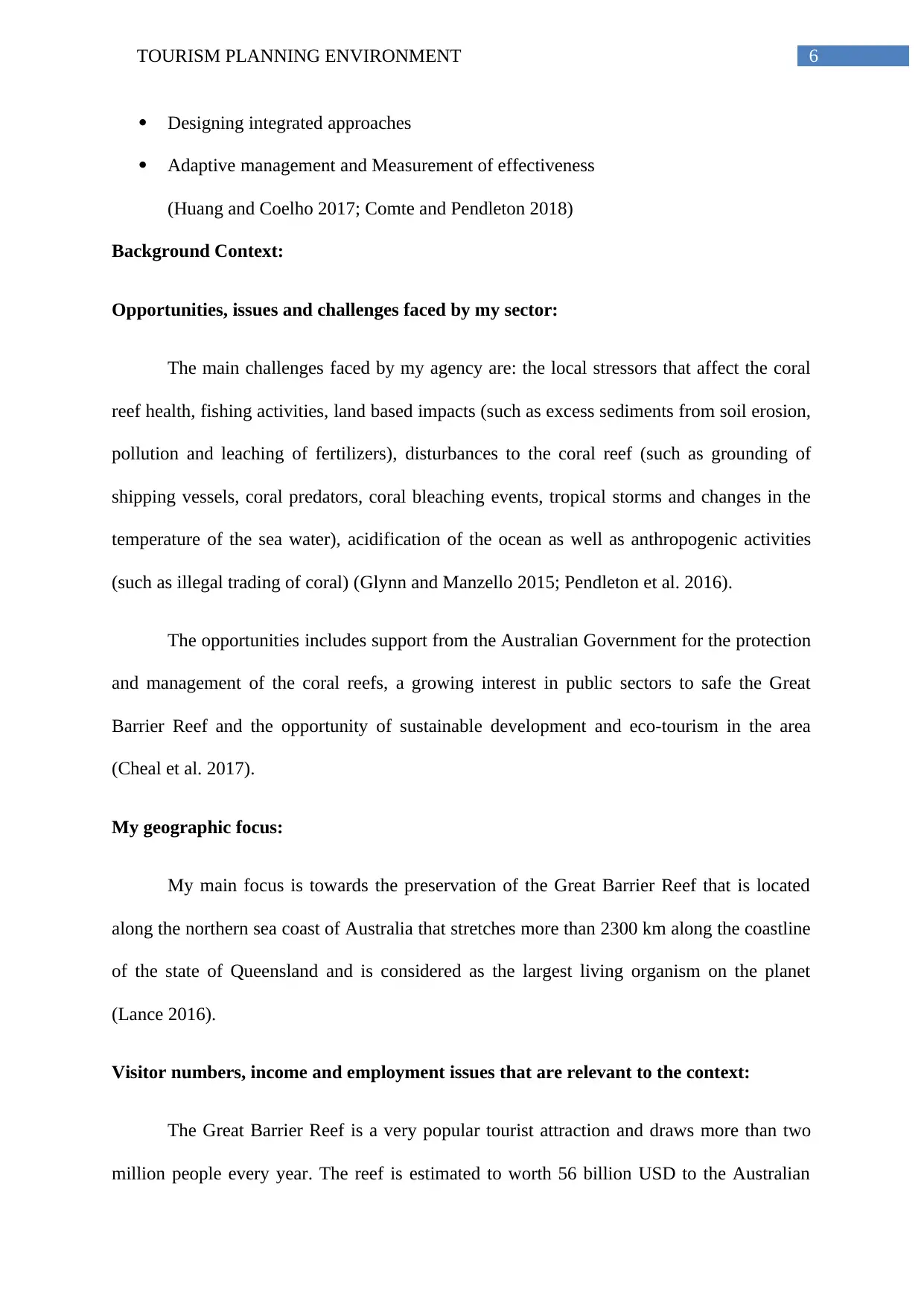
6TOURISM PLANNING ENVIRONMENT
Designing integrated approaches
Adaptive management and Measurement of effectiveness
(Huang and Coelho 2017; Comte and Pendleton 2018)
Background Context:
Opportunities, issues and challenges faced by my sector:
The main challenges faced by my agency are: the local stressors that affect the coral
reef health, fishing activities, land based impacts (such as excess sediments from soil erosion,
pollution and leaching of fertilizers), disturbances to the coral reef (such as grounding of
shipping vessels, coral predators, coral bleaching events, tropical storms and changes in the
temperature of the sea water), acidification of the ocean as well as anthropogenic activities
(such as illegal trading of coral) (Glynn and Manzello 2015; Pendleton et al. 2016).
The opportunities includes support from the Australian Government for the protection
and management of the coral reefs, a growing interest in public sectors to safe the Great
Barrier Reef and the opportunity of sustainable development and eco-tourism in the area
(Cheal et al. 2017).
My geographic focus:
My main focus is towards the preservation of the Great Barrier Reef that is located
along the northern sea coast of Australia that stretches more than 2300 km along the coastline
of the state of Queensland and is considered as the largest living organism on the planet
(Lance 2016).
Visitor numbers, income and employment issues that are relevant to the context:
The Great Barrier Reef is a very popular tourist attraction and draws more than two
million people every year. The reef is estimated to worth 56 billion USD to the Australian
Designing integrated approaches
Adaptive management and Measurement of effectiveness
(Huang and Coelho 2017; Comte and Pendleton 2018)
Background Context:
Opportunities, issues and challenges faced by my sector:
The main challenges faced by my agency are: the local stressors that affect the coral
reef health, fishing activities, land based impacts (such as excess sediments from soil erosion,
pollution and leaching of fertilizers), disturbances to the coral reef (such as grounding of
shipping vessels, coral predators, coral bleaching events, tropical storms and changes in the
temperature of the sea water), acidification of the ocean as well as anthropogenic activities
(such as illegal trading of coral) (Glynn and Manzello 2015; Pendleton et al. 2016).
The opportunities includes support from the Australian Government for the protection
and management of the coral reefs, a growing interest in public sectors to safe the Great
Barrier Reef and the opportunity of sustainable development and eco-tourism in the area
(Cheal et al. 2017).
My geographic focus:
My main focus is towards the preservation of the Great Barrier Reef that is located
along the northern sea coast of Australia that stretches more than 2300 km along the coastline
of the state of Queensland and is considered as the largest living organism on the planet
(Lance 2016).
Visitor numbers, income and employment issues that are relevant to the context:
The Great Barrier Reef is a very popular tourist attraction and draws more than two
million people every year. The reef is estimated to worth 56 billion USD to the Australian
Paraphrase This Document
Need a fresh take? Get an instant paraphrase of this document with our AI Paraphraser
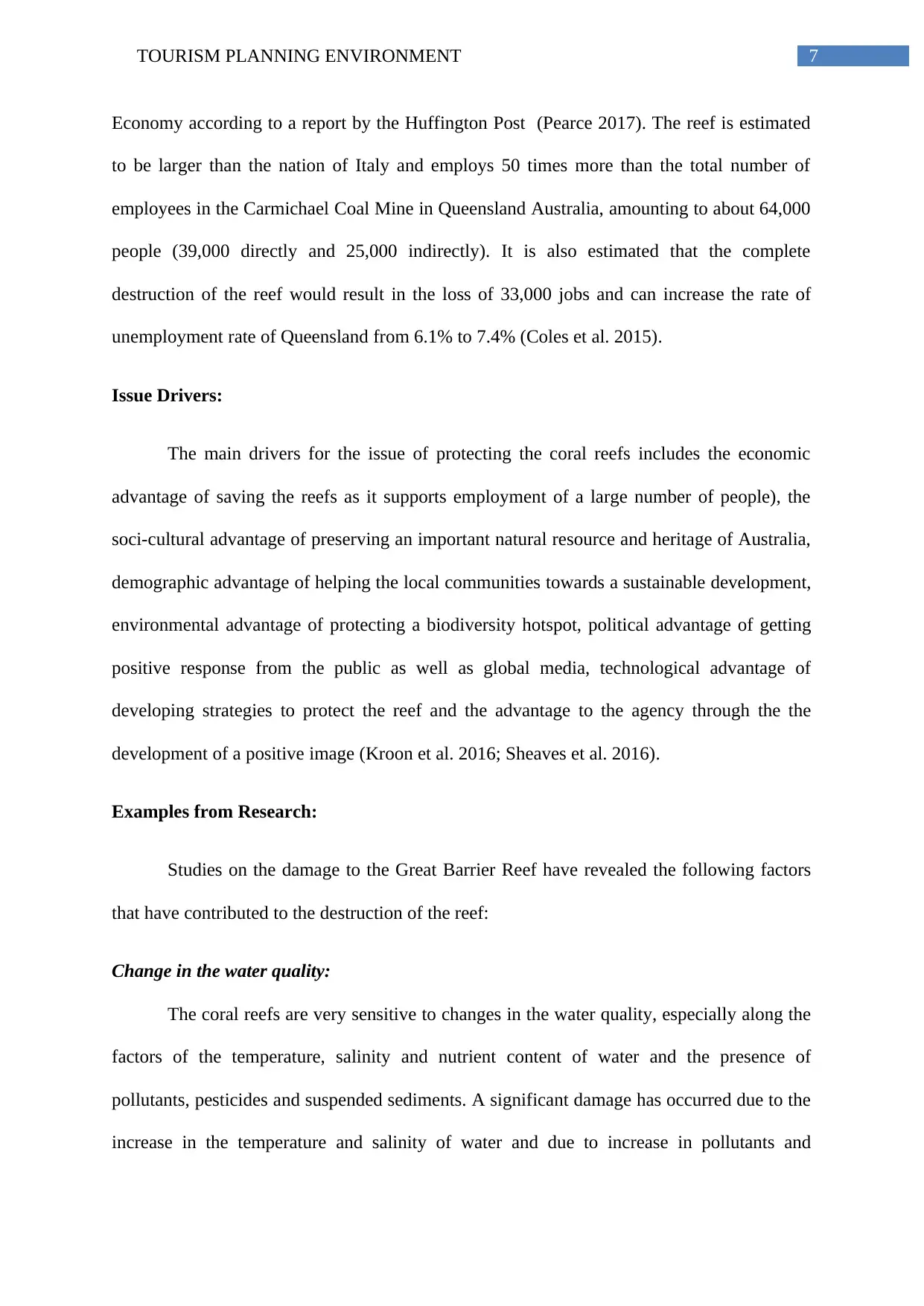
7TOURISM PLANNING ENVIRONMENT
Economy according to a report by the Huffington Post (Pearce 2017). The reef is estimated
to be larger than the nation of Italy and employs 50 times more than the total number of
employees in the Carmichael Coal Mine in Queensland Australia, amounting to about 64,000
people (39,000 directly and 25,000 indirectly). It is also estimated that the complete
destruction of the reef would result in the loss of 33,000 jobs and can increase the rate of
unemployment rate of Queensland from 6.1% to 7.4% (Coles et al. 2015).
Issue Drivers:
The main drivers for the issue of protecting the coral reefs includes the economic
advantage of saving the reefs as it supports employment of a large number of people), the
soci-cultural advantage of preserving an important natural resource and heritage of Australia,
demographic advantage of helping the local communities towards a sustainable development,
environmental advantage of protecting a biodiversity hotspot, political advantage of getting
positive response from the public as well as global media, technological advantage of
developing strategies to protect the reef and the advantage to the agency through the the
development of a positive image (Kroon et al. 2016; Sheaves et al. 2016).
Examples from Research:
Studies on the damage to the Great Barrier Reef have revealed the following factors
that have contributed to the destruction of the reef:
Change in the water quality:
The coral reefs are very sensitive to changes in the water quality, especially along the
factors of the temperature, salinity and nutrient content of water and the presence of
pollutants, pesticides and suspended sediments. A significant damage has occurred due to the
increase in the temperature and salinity of water and due to increase in pollutants and
Economy according to a report by the Huffington Post (Pearce 2017). The reef is estimated
to be larger than the nation of Italy and employs 50 times more than the total number of
employees in the Carmichael Coal Mine in Queensland Australia, amounting to about 64,000
people (39,000 directly and 25,000 indirectly). It is also estimated that the complete
destruction of the reef would result in the loss of 33,000 jobs and can increase the rate of
unemployment rate of Queensland from 6.1% to 7.4% (Coles et al. 2015).
Issue Drivers:
The main drivers for the issue of protecting the coral reefs includes the economic
advantage of saving the reefs as it supports employment of a large number of people), the
soci-cultural advantage of preserving an important natural resource and heritage of Australia,
demographic advantage of helping the local communities towards a sustainable development,
environmental advantage of protecting a biodiversity hotspot, political advantage of getting
positive response from the public as well as global media, technological advantage of
developing strategies to protect the reef and the advantage to the agency through the the
development of a positive image (Kroon et al. 2016; Sheaves et al. 2016).
Examples from Research:
Studies on the damage to the Great Barrier Reef have revealed the following factors
that have contributed to the destruction of the reef:
Change in the water quality:
The coral reefs are very sensitive to changes in the water quality, especially along the
factors of the temperature, salinity and nutrient content of water and the presence of
pollutants, pesticides and suspended sediments. A significant damage has occurred due to the
increase in the temperature and salinity of water and due to increase in pollutants and
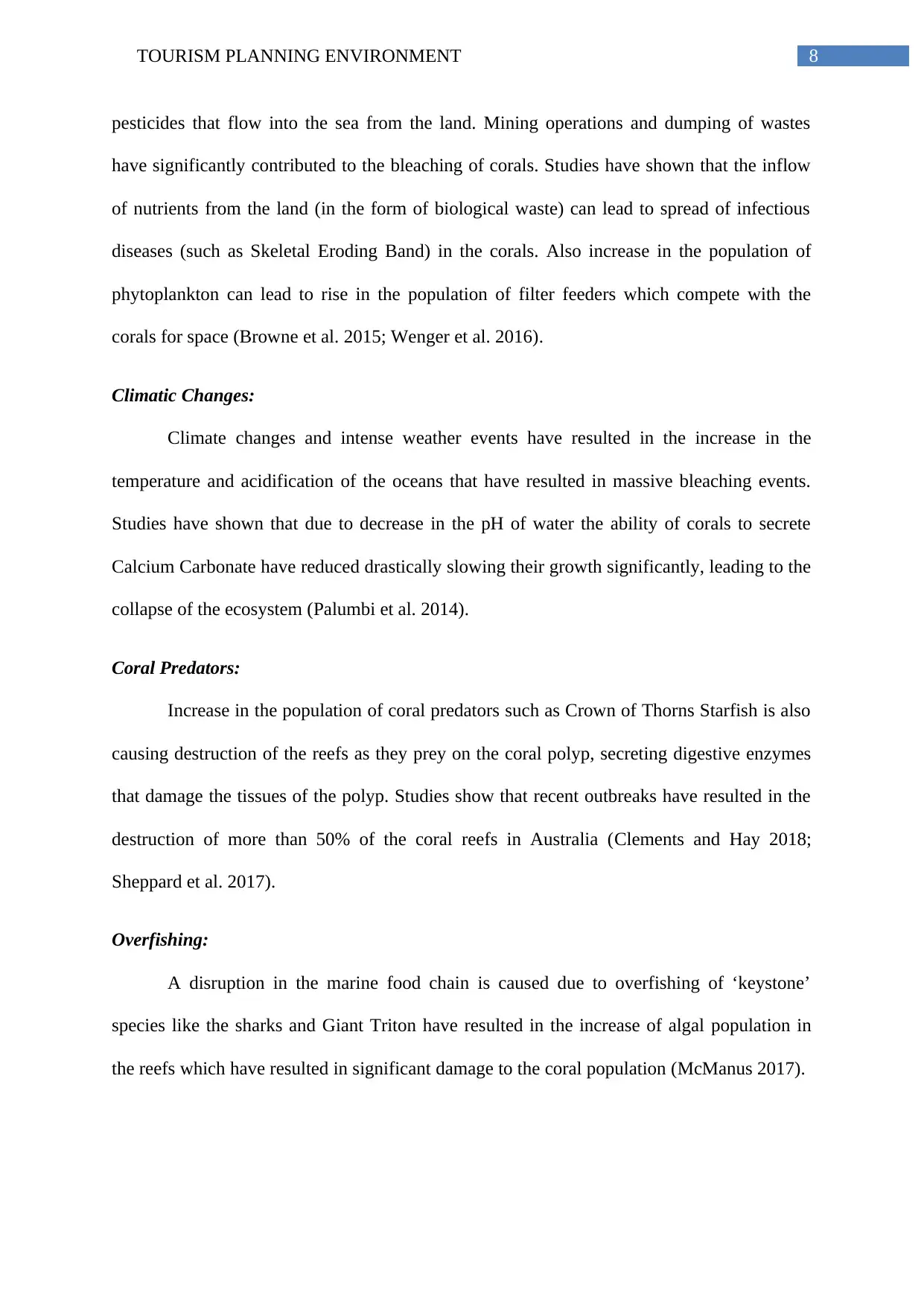
8TOURISM PLANNING ENVIRONMENT
pesticides that flow into the sea from the land. Mining operations and dumping of wastes
have significantly contributed to the bleaching of corals. Studies have shown that the inflow
of nutrients from the land (in the form of biological waste) can lead to spread of infectious
diseases (such as Skeletal Eroding Band) in the corals. Also increase in the population of
phytoplankton can lead to rise in the population of filter feeders which compete with the
corals for space (Browne et al. 2015; Wenger et al. 2016).
Climatic Changes:
Climate changes and intense weather events have resulted in the increase in the
temperature and acidification of the oceans that have resulted in massive bleaching events.
Studies have shown that due to decrease in the pH of water the ability of corals to secrete
Calcium Carbonate have reduced drastically slowing their growth significantly, leading to the
collapse of the ecosystem (Palumbi et al. 2014).
Coral Predators:
Increase in the population of coral predators such as Crown of Thorns Starfish is also
causing destruction of the reefs as they prey on the coral polyp, secreting digestive enzymes
that damage the tissues of the polyp. Studies show that recent outbreaks have resulted in the
destruction of more than 50% of the coral reefs in Australia (Clements and Hay 2018;
Sheppard et al. 2017).
Overfishing:
A disruption in the marine food chain is caused due to overfishing of ‘keystone’
species like the sharks and Giant Triton have resulted in the increase of algal population in
the reefs which have resulted in significant damage to the coral population (McManus 2017).
pesticides that flow into the sea from the land. Mining operations and dumping of wastes
have significantly contributed to the bleaching of corals. Studies have shown that the inflow
of nutrients from the land (in the form of biological waste) can lead to spread of infectious
diseases (such as Skeletal Eroding Band) in the corals. Also increase in the population of
phytoplankton can lead to rise in the population of filter feeders which compete with the
corals for space (Browne et al. 2015; Wenger et al. 2016).
Climatic Changes:
Climate changes and intense weather events have resulted in the increase in the
temperature and acidification of the oceans that have resulted in massive bleaching events.
Studies have shown that due to decrease in the pH of water the ability of corals to secrete
Calcium Carbonate have reduced drastically slowing their growth significantly, leading to the
collapse of the ecosystem (Palumbi et al. 2014).
Coral Predators:
Increase in the population of coral predators such as Crown of Thorns Starfish is also
causing destruction of the reefs as they prey on the coral polyp, secreting digestive enzymes
that damage the tissues of the polyp. Studies show that recent outbreaks have resulted in the
destruction of more than 50% of the coral reefs in Australia (Clements and Hay 2018;
Sheppard et al. 2017).
Overfishing:
A disruption in the marine food chain is caused due to overfishing of ‘keystone’
species like the sharks and Giant Triton have resulted in the increase of algal population in
the reefs which have resulted in significant damage to the coral population (McManus 2017).
⊘ This is a preview!⊘
Do you want full access?
Subscribe today to unlock all pages.

Trusted by 1+ million students worldwide
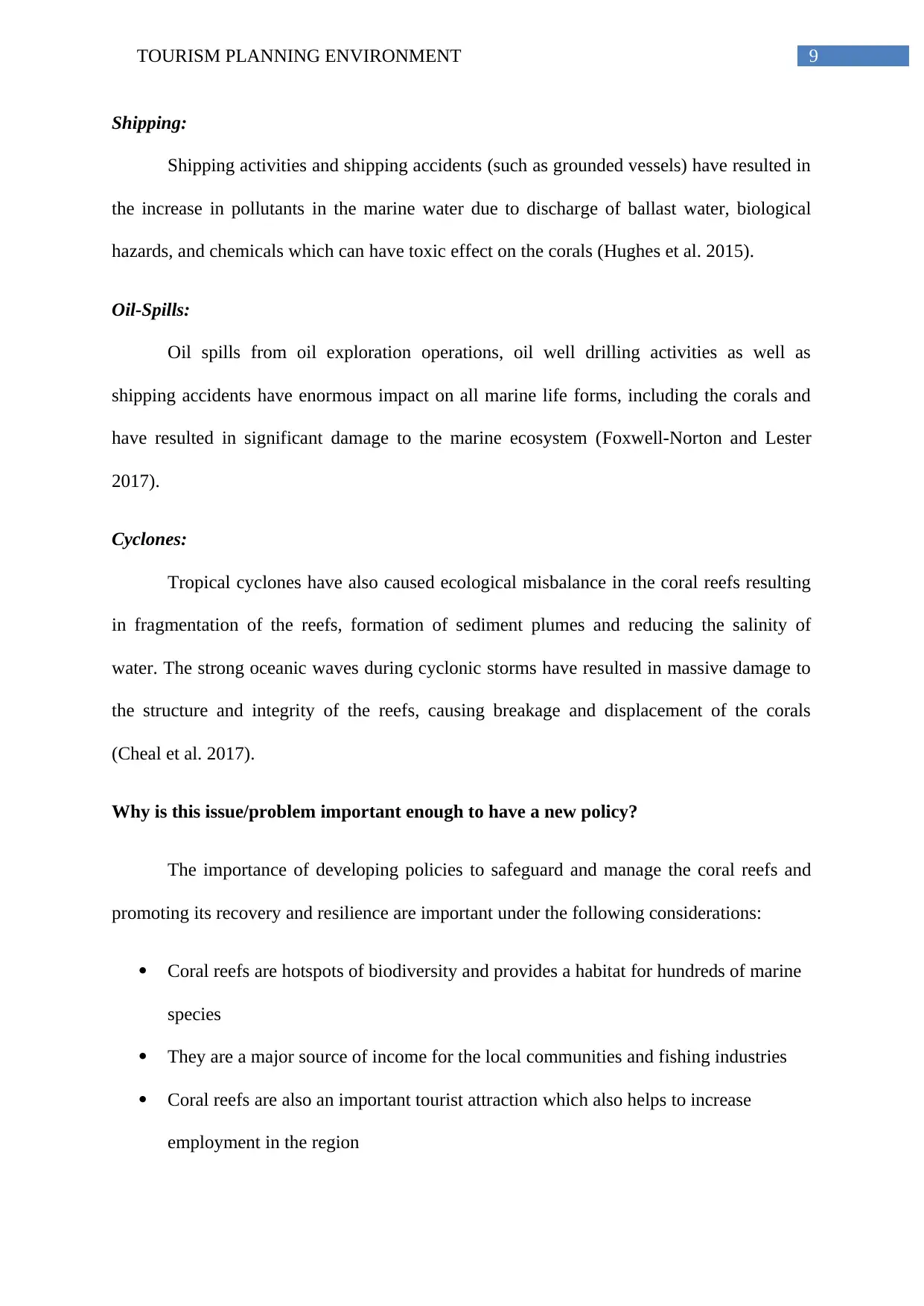
9TOURISM PLANNING ENVIRONMENT
Shipping:
Shipping activities and shipping accidents (such as grounded vessels) have resulted in
the increase in pollutants in the marine water due to discharge of ballast water, biological
hazards, and chemicals which can have toxic effect on the corals (Hughes et al. 2015).
Oil-Spills:
Oil spills from oil exploration operations, oil well drilling activities as well as
shipping accidents have enormous impact on all marine life forms, including the corals and
have resulted in significant damage to the marine ecosystem (Foxwell-Norton and Lester
2017).
Cyclones:
Tropical cyclones have also caused ecological misbalance in the coral reefs resulting
in fragmentation of the reefs, formation of sediment plumes and reducing the salinity of
water. The strong oceanic waves during cyclonic storms have resulted in massive damage to
the structure and integrity of the reefs, causing breakage and displacement of the corals
(Cheal et al. 2017).
Why is this issue/problem important enough to have a new policy?
The importance of developing policies to safeguard and manage the coral reefs and
promoting its recovery and resilience are important under the following considerations:
Coral reefs are hotspots of biodiversity and provides a habitat for hundreds of marine
species
They are a major source of income for the local communities and fishing industries
Coral reefs are also an important tourist attraction which also helps to increase
employment in the region
Shipping:
Shipping activities and shipping accidents (such as grounded vessels) have resulted in
the increase in pollutants in the marine water due to discharge of ballast water, biological
hazards, and chemicals which can have toxic effect on the corals (Hughes et al. 2015).
Oil-Spills:
Oil spills from oil exploration operations, oil well drilling activities as well as
shipping accidents have enormous impact on all marine life forms, including the corals and
have resulted in significant damage to the marine ecosystem (Foxwell-Norton and Lester
2017).
Cyclones:
Tropical cyclones have also caused ecological misbalance in the coral reefs resulting
in fragmentation of the reefs, formation of sediment plumes and reducing the salinity of
water. The strong oceanic waves during cyclonic storms have resulted in massive damage to
the structure and integrity of the reefs, causing breakage and displacement of the corals
(Cheal et al. 2017).
Why is this issue/problem important enough to have a new policy?
The importance of developing policies to safeguard and manage the coral reefs and
promoting its recovery and resilience are important under the following considerations:
Coral reefs are hotspots of biodiversity and provides a habitat for hundreds of marine
species
They are a major source of income for the local communities and fishing industries
Coral reefs are also an important tourist attraction which also helps to increase
employment in the region
Paraphrase This Document
Need a fresh take? Get an instant paraphrase of this document with our AI Paraphraser
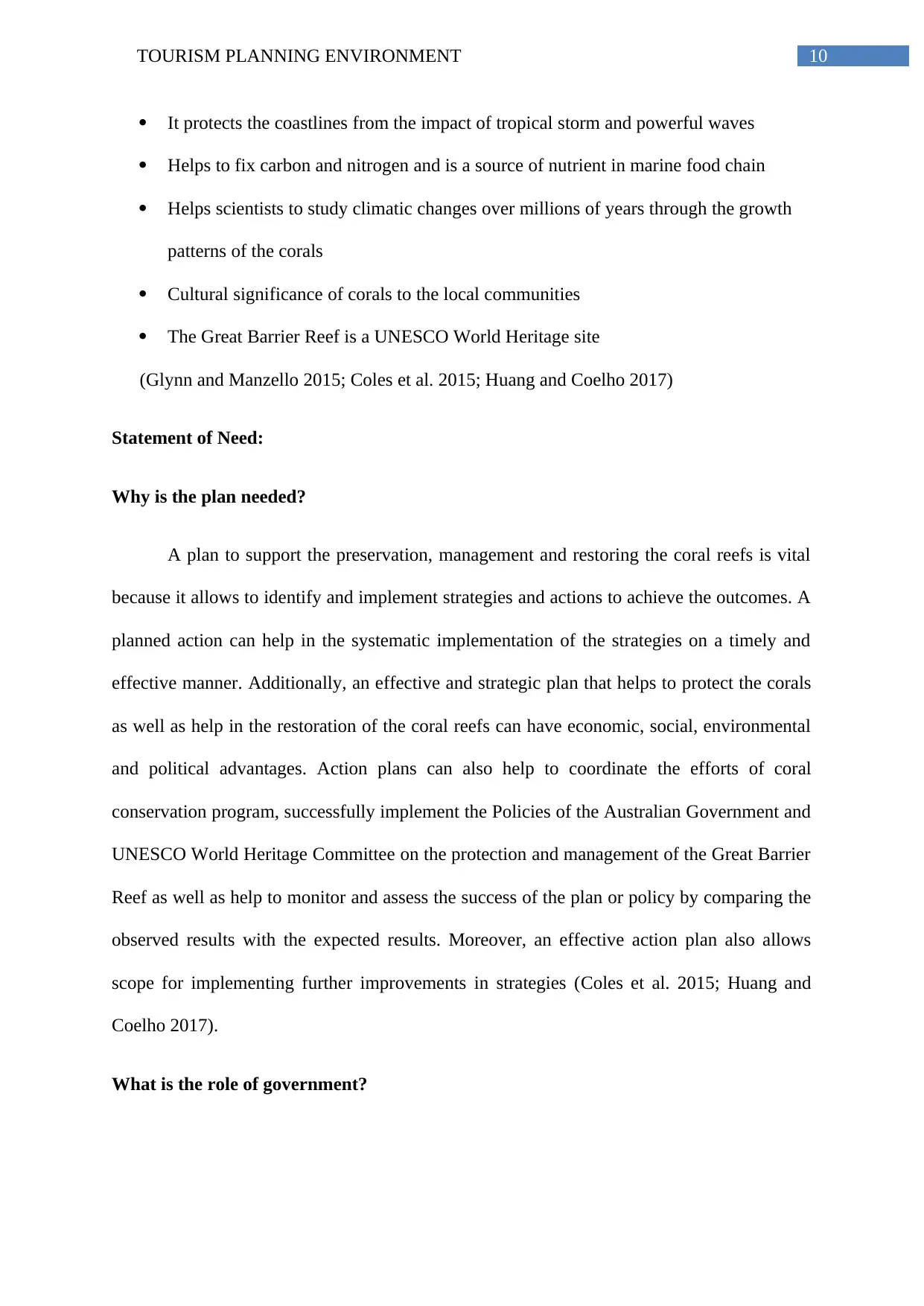
10TOURISM PLANNING ENVIRONMENT
It protects the coastlines from the impact of tropical storm and powerful waves
Helps to fix carbon and nitrogen and is a source of nutrient in marine food chain
Helps scientists to study climatic changes over millions of years through the growth
patterns of the corals
Cultural significance of corals to the local communities
The Great Barrier Reef is a UNESCO World Heritage site
(Glynn and Manzello 2015; Coles et al. 2015; Huang and Coelho 2017)
Statement of Need:
Why is the plan needed?
A plan to support the preservation, management and restoring the coral reefs is vital
because it allows to identify and implement strategies and actions to achieve the outcomes. A
planned action can help in the systematic implementation of the strategies on a timely and
effective manner. Additionally, an effective and strategic plan that helps to protect the corals
as well as help in the restoration of the coral reefs can have economic, social, environmental
and political advantages. Action plans can also help to coordinate the efforts of coral
conservation program, successfully implement the Policies of the Australian Government and
UNESCO World Heritage Committee on the protection and management of the Great Barrier
Reef as well as help to monitor and assess the success of the plan or policy by comparing the
observed results with the expected results. Moreover, an effective action plan also allows
scope for implementing further improvements in strategies (Coles et al. 2015; Huang and
Coelho 2017).
What is the role of government?
It protects the coastlines from the impact of tropical storm and powerful waves
Helps to fix carbon and nitrogen and is a source of nutrient in marine food chain
Helps scientists to study climatic changes over millions of years through the growth
patterns of the corals
Cultural significance of corals to the local communities
The Great Barrier Reef is a UNESCO World Heritage site
(Glynn and Manzello 2015; Coles et al. 2015; Huang and Coelho 2017)
Statement of Need:
Why is the plan needed?
A plan to support the preservation, management and restoring the coral reefs is vital
because it allows to identify and implement strategies and actions to achieve the outcomes. A
planned action can help in the systematic implementation of the strategies on a timely and
effective manner. Additionally, an effective and strategic plan that helps to protect the corals
as well as help in the restoration of the coral reefs can have economic, social, environmental
and political advantages. Action plans can also help to coordinate the efforts of coral
conservation program, successfully implement the Policies of the Australian Government and
UNESCO World Heritage Committee on the protection and management of the Great Barrier
Reef as well as help to monitor and assess the success of the plan or policy by comparing the
observed results with the expected results. Moreover, an effective action plan also allows
scope for implementing further improvements in strategies (Coles et al. 2015; Huang and
Coelho 2017).
What is the role of government?

11TOURISM PLANNING ENVIRONMENT
Reef 2050 Long term Sustainability Plan by the Australian Government:
This serves as a blueprint to support the efforts by the Australian Government to
preserve and manage the Great Barrier Reef and focuses on developing Coral Resilience and
maintain its Universal Value. It provides a strong decisive action plan and has implemented
the following strategies:
Restriction in the capital dredging of the ports of Gladstone, Hay Point/Mackay,
Abbot Point and Townsville within the restricted port limits.
Investing in sustainable development of the reefs which includes funding of 140
Million AUD for Reef Trust and 135 million AUD from the Government of
Queensland to improve the water quality and reducing the impact of fisheries on the
reef.
Managing the development of Gladstone Harbour and Curtis Island
Developing best practices for the planning of ports
Implementing strict management of shipping activities
Addressing the concerns of climatic change and degradation of the environment
Implementing independent review boards for Coral Reef management activities
Developing progress reports on the conservation work for the coral reefs
Improving the quality of water
(Tarte et al. 2017)
Reef Trust:
The Reef trust utilises both funding from the Government and Private sources to
improve coastal marine habitats and quality of water in the Great Barrier Reef and its
catchment zones.
The trust has an investment plan of AUD 444 million to address the main threats to
the reef
Reef 2050 Long term Sustainability Plan by the Australian Government:
This serves as a blueprint to support the efforts by the Australian Government to
preserve and manage the Great Barrier Reef and focuses on developing Coral Resilience and
maintain its Universal Value. It provides a strong decisive action plan and has implemented
the following strategies:
Restriction in the capital dredging of the ports of Gladstone, Hay Point/Mackay,
Abbot Point and Townsville within the restricted port limits.
Investing in sustainable development of the reefs which includes funding of 140
Million AUD for Reef Trust and 135 million AUD from the Government of
Queensland to improve the water quality and reducing the impact of fisheries on the
reef.
Managing the development of Gladstone Harbour and Curtis Island
Developing best practices for the planning of ports
Implementing strict management of shipping activities
Addressing the concerns of climatic change and degradation of the environment
Implementing independent review boards for Coral Reef management activities
Developing progress reports on the conservation work for the coral reefs
Improving the quality of water
(Tarte et al. 2017)
Reef Trust:
The Reef trust utilises both funding from the Government and Private sources to
improve coastal marine habitats and quality of water in the Great Barrier Reef and its
catchment zones.
The trust has an investment plan of AUD 444 million to address the main threats to
the reef
⊘ This is a preview!⊘
Do you want full access?
Subscribe today to unlock all pages.

Trusted by 1+ million students worldwide
1 out of 26
Related Documents
Your All-in-One AI-Powered Toolkit for Academic Success.
+13062052269
info@desklib.com
Available 24*7 on WhatsApp / Email
![[object Object]](/_next/static/media/star-bottom.7253800d.svg)
Unlock your academic potential
Copyright © 2020–2025 A2Z Services. All Rights Reserved. Developed and managed by ZUCOL.





